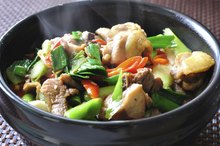Example of a Personal Diet Analysis
A personal diet analysis involves a dietitian or nutritionist evaluating your daily diet to determine its healthfulness. There are many reasons that diet analysis can be necessary. You may have health concerns or problems such as attention-deficit hyperactivity disorder, or ADHD, obesity, diabetes or Crohn's disease. There are many in Western society who would benefit from diet analysis as many of the typical Western diets are out of balance nutritionally and this can cause a host of diseases and other health problems.
Software, Online Tools
There are software packages that can be used at home. These involve you entering your daily food intake into your computer and allowing the software to do the diet analysis. Your diet could then be modified and re-entered until the right nutritional content was reached. Many dietitians do this for their patients. The software costs anywhere from $2 each month online to $800 for the software dietitians use. There are also free tools for diet analysis, such as the U.S. Department of Agriculture's tool, ChooseMyPlate.gov.
In-Person Diet Analysis
Is There a Diet Drink Made With Stevia?
Learn More
There are dietitians and nutritionists who do one on one counseling. Many nutritionists charge under $100 per hour. Thirty to 90 minutes per week for several weeks, often up to 10 weeks, would be sufficient for most people.
Food Journal
In person, individualized nutrition counseling typically involves you keeping a diary or a food journal of what you eat each day. Most food journals are kept for a few days to a few weeks. Your diet is then evaluated for nutritional content, balance, calories, portion sizes, fat and carbohydrate intake, etc. The nutrition expert will then review your journal and make suggested changes to your diet.
Example of a Daily Food Diary
Morgan Detox Diet
Learn More
Breakfast: 2 eggs 2 tbsp. butter 1 piece white toast 3 cups coffee
Lunch: 1 hamburger 1 large fries 1 large soda
Snack: 1 cup barbecue potato chips
Dinner: 2 cups chicken casserole w/potatoes, cream of chicken soup, cheddar cheese, onions 1 french roll
Dessert 1 cup chocolate ice cream
Potential Problems
This diet is high in cholesterol, calories and saturated or bad fat. This diet is also high in processed foods including white flour that have many nutrients such as vitamins, minerals and amino acids removed. As a result, this diet is also low in fiber. While it does contain a sufficient amount of protein, it actually contains too much. This diet also contains enough servings of grains but not enough whole grains as guides like the food pyramid intend. The body responds similarly to white flour as it does to sugar, so it should be considered more of a sugar than a grain although it does contain some nutrients. Sugars and fats are empty calories and need to be limited, according to ChooseMyPlate.gov. This diet is too high in the fats and sugars and needs more fruits, vegetables and whole grains. Foods like fruits, vegetables and whole grains contain many important nutrients such as vitamins, minerals, amino acids and fiber, which this diet and many typical Western diets are lacking in.
Recommendations
A nutritionist or dietitian would suggest something like the following:
Breakfast: 1 egg 1 tbsp. canola oil margarine 1/2 apple sliced 1 piece whole-grain bread 1 to 2 cups green tea or juice
Lunch: 1 tuna sandwich on whole-grain bread w/lettuce and tomato and 1 tbsp. low-fat mayonnaise or 1 turkey or veggie burger on whole-grain bread with lettuce and tomato, ketchup and mustard, 1 teaspoon of mayonnaise if desired 1/2 cup baked chips 1 glass water or juice
Snack: 1 whole orange or 4 slices of 3-4 inch celery sticks with peanut butter
Dinner: 1 cup chicken casserole with mozzarella cheese, onions, scalloped potatoes, low-fat milk 1 cup green salad with 1 tablespoon of olive oil and vinegar dressing 1 to 2 pieces whole grain bread of their choice -- i.e., slices, roll or baguette 1 glass water or juice
Dessert: 3/4 cup chocolate frozen yogurt
Explanation of Recommendations
The recommendations made will add many nutrients and will lower the amount of calories, bad fat and cholesterol. This modified diet is much more balanced and incorporates the right amount of each food group. There are many ways to modify your diet. Personal counseling and interviewing is useful in determining what types of foods to incorporate into your meal plan. This diet was modified by taking the client's existing choices and making them more healthful. Personal consulting by a nutrition expert is the ideal method for achieving that and finding a diet solution that will last.
Related Articles
References
- Krause's Food, Nutrition and Diet Therapy, 11th edition; K. Mahan, S. Escott-Stump
- Prescription for Nutritional Healing; Phyllis A. Balch
- ChooseMyPlate.gov: SuperTracker and Other Tools
- ChooseMyPlate.gov: What Are Empty Calories?
Writer Bio
Elizabeth Kahn began writing professionally in 2006, while working in public education. She teaches nutrition to students, families and her local community. Kahn earned her Bachelor of Science in clinical nutrition from UC Davis and is pursuing a Master of Arts in education at Chapman University.








